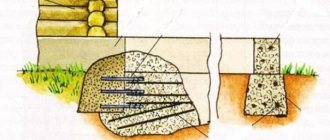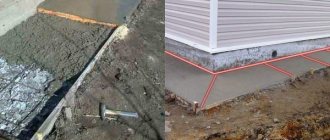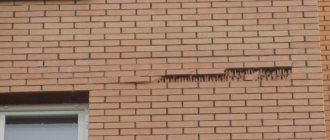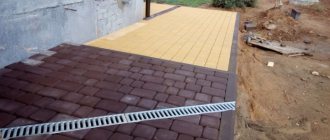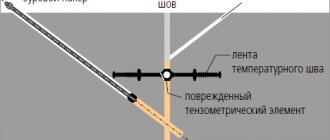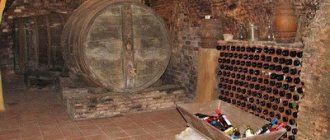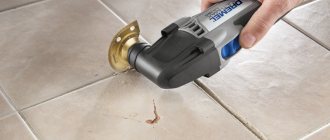Types of expansion joints in the blind area design
Forces of different origins act on the base of the house and the footpath, so the seams in the blind area can be of different types and depend on:
- climatic conditions of the area;
- used building materials;
- soil characteristics.
Shrink seams
The concrete coating dries unevenly and in its central part the height is slightly less. This distortion causes cracks to appear in the screed.
Photo source: stroyfora.ru
When constructing a blind area, in order to avoid destruction of its structure, cuts are made using a special joint cutter, or by laying slats to a depth equal to a third of the height of the covering. After their dismantling, the resulting voids neutralize the destructive stress on the surface of the coating.
Temperature
Significant temperature changes lead to compression or expansion of concrete. To avoid destruction of the screed, expansion joints are formed in all reinforced concrete elements, except the foundation, in the blind area by laying a damper tape between the wall of the building.
Sedimentary
These expansion joints divide the blind area into separate parts. Such a surface structure prevents destruction in the event of settlement of the structure due to heterogeneous soil and different weights of elements.
Installation of the profile is carried out when installing waterproofing.
Seismic
Photo source: betonzavod-info.com
They are used only in regions with high seismicity, giving the screed structure the necessary mobility.
Design standards for a building element
The installation requirements of all construction projects, in particular blind areas, are controlled by a variety of generally accepted normative documents, which specify a number of rules and features.
If your plans are to fulfill everything according to the existing requirements, then you need to comply with all of them, these are: the width of the blind area according to GOST, the height, the angle of inclination of the structure and much more. This element plays a significant role in the durability and comfortable operation of the building itself, and prevents water from entering the foundation structure. It serves as a barrier against flood and rainwater entering near the house, prevents subsidence of the foundation, is a decoration, and plays the role of a special sidewalk around the perimeter of the house.
Many people still don’t know what a building’s blind area is. This is a strip of concrete, asphalt and paving slabs around the house. According to building codes and regulations, it must be installed, as it serves as a barrier to prevent water from entering the foundation structure, which in turn can cause great harm.
This element is made of waterproof material around the entire building. Its width must be at least 70 cm and must be arranged from the wall of the house to the outside. In general, this size depends on the soil structure and the length of the eaves overhangs. In addition to the main function of protecting the foundation from water, the blind area can play the role of a pedestrian zone.
Also, the presence of this element makes it possible to keep the front part of the building clean. Water flowing from roofs hits the ground, thereby splashing components onto the walls. The picture after this, of course, is unsightly, and installing a perimeter strip of concrete, asphalt and paving slabs does not allow this.
What brings much more trouble is that if there is no blind area for a building built on heaving soils. In winter, soil saturated with water swells unevenly, which has a bad effect on the foundation. In this case, insulation is installed around the perimeter of the site. This component also plays a significant role if the house is built on a shallow foundation.
SNiP requirements
According to SNiP dated 2.02.01 83, very often defined as SNiP for the blind area, which has general amendments regarding the installation of the base of construction projects, combining indicators for deformation, the influence of groundwater and more. It is worth following SNiP dated 2.02.01 83 for plan calculations and compliance with certain standards regarding soils, etc. But this document does not take into account certain indicators, so it is not worth recommending it as the main and only one.
In accordance with III-10-75 SNiP, the blind area of the building must be very close to the wall of the house along the entire perimeter. The slope of these structures should be from 1% to 10%. In places that are difficult to reach for instruments, it is worth manually compacting the base part of this building element so that traces of impacts disappear and the material used stops moving.
The external part of these building elements within the boundaries of rectilinear areas should not include curved sections of more than 10 mm in the horizontal and vertical directions. It is important that the concrete poured for these structures meets all the requirements of the material used for the construction of road structures. The standards required for the installation of blind areas are specified in the documents GOST 9128-97 and GOST 7473-94.
This building element is divided into parts using expansion joints. In winter, when the temperature drops below zero, heaving forces begin to work and the whole structure can be torn into pieces. When expansion joints are installed, this should not happen. They should be installed at a distance of every 1.7-2 meters.
To carry them out, you should take a building level, place one of the ends on the formwork being used, bring the second to the surface of the foundation and make a pencil mark on the horizon. And since you need to make a slight slope and set the level of this seam, it is worth adding 3 cm up to the horizon mark on the foundation. The second end must be laid close to the upper corner of the formwork.
Expansion joints in the blind area should be made using concrete mixture. Pour a thin strip of concrete within the formwork along the edges, insert a beacon along the mark on the foundation. It is important that the lighthouse extends out of the concrete to a height of 5 cm. By using sealants in expansion joints, the service life of this building element can be extended.
We suggest you familiarize yourself with what material can be used to cover a bathhouse
The installation of blind areas should also include expansion joints in two directions. The biggest mistake in installing these components is their absence. Expansion joints are needed when the strip is created from a concrete mixture or asphalt. During temperature changes, ground movement occurs.
To prevent such phenomena, it is worth making a blind area together with an expansion joint, approximately 1-2 cm, using bitumen, roofing felt or sealant. If the building already has foundation waterproofing, then it is used as an expansion joint and raised to the extreme level of the building element. In addition, it is important to make this cut across the concrete structure around the perimeter of the house every 2-2.5 meters.
You can make an expansion joint in the blind area using a board whose thickness is 10-20 mm, soaked, treated with heated bitumen and a septic tank. It is installed on an edge in freshly poured concrete.
If when building blind areas you take into account the width of the roof overhangs and the structure of the soil, then during operation defects are unlikely to arise in the future. The width of the concrete or asphalt strip or tiled sidewalk should be wider than the cornice if the soil is normal. If the building is built on unstable soils, then its width should be greater than 1 m.
If you plan to build a building with waterproofing, then you should monitor during operation for possible damage to the structure. To avoid defects in the blind area of the building, experts recommend bringing the waterproofing to the required level - the edge of the structure.
Of course, the construction of any facilities must be carried out in accordance with the data of regulatory documents. To prevent subsidence of the structure, it should be made waterproof. If the soil on which the house is being built can sag due to its properties, then the strip of concrete, asphalt or paving slabs must be at least 2 meters.
Also, in order to prevent the appearance of defects during operation of this structure, it is important to perform reinforcement using metal mesh. In particular, this plays an important role in the construction of structures on heaving soils.
There are many features that should be taken into account when constructing building structures, but among the large number of requirements, we suggest you highlight the main ones. The blind area includes the following design standards:
- the design must include a slope to the outside of the building. This makes it possible to drain water away from the foundation. The slope angle must be at least 1.5 degrees;
- a gap of 10-20 mm should be left between the wall of the house and the blind area, where sand is poured or sealant is poured;
- according to SNiP 2.02.01 83, the strip of this building element should have a width of 1.5 m on type I soil, and 2 m on type II soil;
- if this element also serves as a pedestrian area, then it is important to take into account the requirements of State Regulations 31.01.025;
- the height of the plinth depends on the material used to build the structure. If it is concrete or paving stones, then the indicator should be more than 0.5 m. If crushed stone and gravel are used, then the indicator should be 0.3 m.
Also, some people wonder: is it possible to make a blind area in winter? Experts say that this procedure can be done during the cold season, but it is important to comply with some requirements.
The nuances of laying expansion joints
Only an experienced surveyor can calculate the required number of seams.
Average distance between seams:
- 60 cm – for wooden buildings;
- 15 cm – for brick buildings.
The selection of thermal and waterproofing for the foundation base is carried out depending on its type: for tiled ones, tarred tow is recommended, for strip ones - separate insulating layers.
The construction of the basement structure involves the use of wooden slats, the grooves of which are filled with bitumen.
Photo source: lafargeholcimrus.ru/
The nuances of proper creation
It is advisable that the number of seams be calculated by an experienced surveyor. To correctly make a seam that will protect the foundation from deformation, you need to follow some rules. So, the height of the seam should be equal to the height of the foundation, and the distance between each of the seams can be determined based on calculations.
The structure of the building itself is also important. For example, if the house has an extension, then along the corner boundaries it will also be necessary to create expansion joints, which should have an average width of 10-12 cm. You need to choose thermal and waterproofing for foundations in different ways - for example, a slab-type foundation will be better protected using tarred tow, and a tape-type base will require separate thermal insulation and waterproofing.
When creating a blind area, wooden slats are used, which must then be filled with bitumen. A seam located between the blind area and the base of the house will not be needed if the base is already insulated from moisture and cold.
The above tips can be called universal and suitable for all types of expansion joints. Following them will help you create a strong and durable foundation that will last for decades.
To protect the foundation from the effects of water, a waterproof strip of concrete or asphalt, called a blind area, is installed around the building.
Its proper arrangement will preserve the integrity of the foundation for many years. But when making a blind area with your own hands, you need to know which option is best suited for a particular case.
In SNiP (building codes and regulations) you can find more than 20 different blind areas, the use of which depends on several factors:
- climatic conditions;
- type of soil;
- type of building erected;
- available building materials.
The blind area must necessarily consist of an underlying layer and a covering.
- The underlying layer is the basis for the coating, the thickness of which varies between 20-30 cm. The blind area can be formed from various materials. For example, from crushed stone, sand, clay or gritsovka. Clay is the most commonly used material because of its waterproofing properties.
- The coating can be completely different, the main thing is that it does not succumb to erosion and does not allow water to pass through. The blind area can be made of concrete, asphalt or small cobblestones. You can also lay it out with paving slabs. The choice of building materials for the blind area is significantly influenced by their cost.
Sometimes, in order to save money, a temporary soft coating is used in the form of a mixture of clay and sand or crushed stone. This blind area is not durable, but it is quite easy to restore.
Attention! The arrangement of the blind area must be done immediately after the construction of the building. Work must be carried out before the first cold weather.
Stages of work
- Markings need to be made along the perimeter of the building. The width of the blind area should be at least 60 cm when it is arranged on a normal type of soil or 1 m on subsidence soils. You also need to take into account that the blind area should protrude 20 cm from the edge of the roof overhang.
- According to the markings, a trench is dug, the depth of which depends on the thickness of the underlying layer and varies from 20 cm to 50 cm.
- The soil inside the ditch must be treated with a herbicide (a weed control agent), which will prevent the growth of plants whose roots could damage the foundation or blind area.
It is also necessary to clean the foundation of the building from contamination. - An expansion joint is made: a rubber-bitumen compound (bitumen mastic) is applied to the foundation and covered with two layers of roofing felt. It will take a day for the compound to harden, after which work can continue.
- Formwork is installed at the outer edge of the trench recess, the upper edge of which should protrude 20 cm from the edge of the trench. The formwork is assembled from boards knocked together into panels.
- The formation of the underlying layer begins, for which the following are used:
- clay – 10 cm;
wet sand – 10 cm;
- mixed-grade crushed stone – 8-10 cm.
- Concrete solution is being prepared. For this, it is better to use cement grade 200M and higher.
- The concrete surface is being poured.
All layers after distribution of materials must be thoroughly compacted.
We suggest you familiarize yourself with Attaching the rafters to the floor beam
Attention! The blind area should have a slope towards the outer edge. It is formed by compacting the soil in a prepared trench or during the process of laying the covering. Its minimum value is 2% of the width of the blind area: with a width of 50 cm, the slope is 1 cm.
An expansion joint is a strip between the foundation and the blind area, which consists of special plastic building materials: bitumen mastic and roofing felt. It protects the building foundation from pressure from the blind area during soil heaving.
To form an expansion joint, the following work is carried out:
- the foundation, the size of the trench, is cleared of contamination;
- a 2 mm layer of bitumen mastic is applied to the prepared base of the building;
- the mastic is covered with two layers of roofing felt;
- Allow 24 hours for the mastic to harden;
- Work is underway to further equip the blind area.
Advice! The presence of cracks or gaps in the blind area will result in the impact of harmful factors on the foundation, which can lead to its destruction.
When arranging the blind area, a drain is formed, which will prevent excessive wetting of the adjacent soil due to precipitation running off from the building. Thanks to it, water is diverted to specially designated places.
The drain must have a slope that will ensure the correct direction of water flow. It is advisable to take this into account when forming the blind area, otherwise the ribs of the drainage gutters will not coincide with its surface.
When arranging a drainage system, the following work is carried out:
- a trench 15 cm deep and 30 cm wide is formed along the edge of the blind area;
- its bottom is covered with sand and compacted;
- formwork is placed with a slope of 1.5-2 cm;
- ready-made gutters are laid out close to the blind area or pipes to form a concrete gutter (the pipes are buried halfway: after they are removed, a gutter will be formed in the concrete);
- concrete is poured;
- after 12 hours, the formwork is dismantled.
Important! To increase the stability of a concrete gutter poured, reinforcement must be placed at its bottom.
A blind area is a protective strip around a house made of a waterproof coating. The most common material for a blind area is concrete. However, this is not the only option, and not the best one.
Some believe that the blind area performs only a decorative function, giving the building a finished look. This opinion is wrong. This article tells you what tasks a soft blind area performs and how to make it yourself.
There are no unimportant moments in the process of building a house. One of them is the technology of building a blind area and the choice of material for its construction. Why do you need a blind area around the house? - you ask.
Its main function is to drain melt and rain water from the foundation, plinth, and basement. Proper arrangement of the blind area can have a positive effect on the operational life of the foundation of the house.
A soft or flexible blind area is an option that requires a little more money and labor. However, compared to a concrete blind area or a crushed stone blind area, it has a number of advantages, even despite its high cost:
- The soft blind area does not require repair, unlike hard surfaces;
- More frost-resistant than concrete;
- Gradual subsidence and vertical vibrations of the soil will not cause any harm to it;
- Waterproofing material laid under the lower layers of the blind area will reliably protect the foundation from water and moisture (for more detailed information on how to waterproof a blind area, read this article);
- Any decorative material is suitable for a soft blind area, from wooden walkways to facing stone;
- You can make a soft blind area for the foundation of a house with your own hands. To do this, you will need to follow some rules and stock up on the necessary material.
The flexible blind area consists of several layers, which will require different materials. First of all, you will need high-quality waterproofing material. It can be roofing felt, polyethylene or PVC membrane. The film must be frost-resistant, used for the construction of strip foundations.
If the soil is loose, clay will be needed for the lowest layer. Sand and crushed stone are suitable as drainage material. Instead of the latter, expanded clay, pebbles or gravel are sometimes used.
Note! The clay that is used to create the bottom layer of the blind area should not contain sand.
In order to distribute the load and separate the fractions, geotextiles are used. This material allows water and air to pass through well. Recently it is often used for installation work.
Geotextile is a woven or non-woven material made from polyester fiber. The compressed fibers are fluffed and separated into individual threads.
The fabric obtained from the threads is fed to a needle punching machine, where many needles form its linen structure.
In order for the protective screed around the house to last more than 1 season and not require rework every year, the builder needs to take into account:
- features of the land plot in terms of geology and relief;
- water drainage system;
- the need and location of expansion joints of various types;
- required dimensions and material of the blind area.
If the surface will enter a pedestrian area, possible additional loads should be calculated. The outer coating can play not only a decorative role, but also improve overall strength and wear resistance. The distance between the seams in the blind area is on average 2-2.5 m. More accurate calculations can be made by a specialist who will take into account the material of the walls and the nature of the foundation. For wooden houses with a lightweight concrete base, the distance, type of joint, and its width will differ.
A holistic creation of a blind area screed, organization of seam cavities, and finishing procedures are required. Take into account:
- Features of geology and relief. The land plot is assessed by specialists.
- Water saturation, drainage systems, removal of water masses from the soil, ducts.
- Location of deformation cuts.
- Size of the blind area.
What fills the seams of the blind area?
Materials for filling joints are characterized by elasticity, plasticity, compressibility with immediate restoration of the original shape.
Damper tape
Able to prevent cracks in the screed when it dries, compensating for the load from adjacent building structures.
Sealing cord
Produced from foamed polyethylene. It is divided into solid type and pipe type. Its diameter should be 1/4 greater than the width of the seam.
Mastics and sealants
Modern sealing agents are divided into:
- acrylic;
- silicone;
- polyurethane.
They can be 1-component - completely ready for use, or 2-component - prepared by combining the ingredients before application.
Mastics are often used to seal deformation gaps from the outside and are applied to pre-laid damping material.
Photo source: seventools.ru
Profiles
They come in all sorts of sizes and configurations. Made from rubber, plastic, metal or combinations thereof. Some models are installed when the mortar is poured, others are mounted in the groove after the base has hardened.
How to make and why do you need an expansion joint in the blind area?
Concrete foundations are the most durable, reliable and durable.
However, concrete is a capricious material when forming structures, surfaces and their operation. Loads acting on the material and in the material, which have different causes, lead to cracking of the monolithic surface.
This happens if measures are not taken in time to create compensation cuts that prevent such phenomena.
This is a targeted fragmentation of the concrete base (floor, wall, roof, etc.), which weakens the action of external and internal forces (stresses) leading to uncontrolled deformation and destruction of the concrete monolith to its entire depth.
Such deformations can cause a decrease in the performance of buildings. The compensation section reacts and dampens changes in the geometry of a concrete slab consisting of several independent fragments.
Such seams are a serious factor in ensuring the reliability and durability of structures.
The structural elements of buildings are connected and constantly interact with each other against the background of the fact that buildings change geometric dimensions under the influence of changes in temperature and humidity conditions of operation, shrinkage of the frame, and settlement of hardening concrete monoliths.
All this causes stress in the nodes of a single structure of the structure, although often such changes in the geometry of elements are visually invisible.
The creation of cuts promotes the uniform distribution of additional loads (forces, stresses) by compensating for changes in the geometric dimensions (expansion, compression, twisting, shearing, bending, etc.) of the material that arise due to factors acting on the concrete (or in the concrete).
Loads always affect structures, but without formed expansion joints they entail deterioration in the characteristics of foundations, the occurrence of cracks, manifestations of structural deformations, an increase in internal stresses, a reduction in service life, etc. For example, heating/cooling of walls leads to a slight change in their dimensions, which in turn creates stress in the material. Larger wall dimensions mean greater stress.
They cause cracking (in concrete screeds, interior decoration) and are transmitted through a rigidly connected frame to floors, beams, stairs, foundations, etc.
A minimal shift in the position of the wall at the point of stress will immediately threaten the integrity of the rigid structure of the building. The duration of the impacts and their magnitude can even cause destruction of the structure’s frame.
Movements and seasonal heaving of soils also manifest themselves as a factor in the destruction of blind areas if temperature cuts are not provided for in them.
Types and purpose of joints in concrete.
The nature of the loads that the cuts must compensate for is the main feature of their classification.
They are divided into stationary (conditionally) - technological and shrinkage, as well as sedimentary, insulating and temperature, deformation.
Interruptions in working with concrete are accompanied by the formation of technological gaps when a cushion of material, cast earlier, adjoins the edge of a new section of the monolith.
Shrinkage cuts, by fragmenting the slab, weaken tensile stresses in the hardening material, which facilitates the passage of cracks below the cut without reaching its surface or the passage of a fault along the seam.
They compensate for deformation and shrinkage due to uneven loss of moisture in different areas of the screed.
They are often combined with seams, the task of which is to compensate for vertical shifts in individual parts of structures due to uneven settlement of the soil under the building.
Expansion joints relieve the assembly joints of structural elements from torsional deformations, transverse and longitudinal stresses.
They are formed in places where the floor adjoins columns, flights of stairs, ramps, curbstones, on breaks in the planes of the material, areas of stepped differences in the height of screeds, etc.
Insulation joints are necessarily created at the junction of the floor with walls, stairs, columns, etc. Their task is to suppress the transfer of deformations (temperature, shrinkage, etc.) from the structure frame to the floor screed.
This separation prevents the passage of shock sound waves into the premises through the screed and back. Expansion joints are formed to compensate for the movement of soils and buildings relative to the blind area.
Its fragmentation and elastic binding to the foundation provide load damping.
How are they performed?
There are two methods of forming seams using diamond or abrasive wheels:
- installation - when at the pouring stage the concrete is divided into fragments using damping materials laid throughout the entire depth of the slab (glass, timber, polymer tapes, plastic lining, etc.), which can be removed from the seam or remain in it;
- cutting - when a hardening concrete slab is cut to a fixed depth, and the formed seams are sealed with polymer sealants, mastics, closed with special structures or left unfilled. The pitch (strip width) of cutting is determined as follows: the height of the screed (in cm) is multiplied by the factor “24”. The result is the step of arranging the seams (in cm).
They are made perfectly straight; they are allowed to intersect only at right angles. At the same time, the joints of the cuts should not form the letter “T” in plan. When it is impossible to exclude the intersection of seams in the form of a triangle in the plan, the figure is made equilateral.
The minimum joint width is 0.6 cm, which depends on the height of the artificial stone layer.
For wet concrete, cutting can be carried out within 12 - 72 hours after laying (depending on the air temperature), however, the situation should be excluded when the concrete has completely dried and the cut edge of the material crumbles.
The depth of the sections is 1/4 - 1/2 of the height of the slab. The indoor floor area is considered indivisible (up to 30 m2) when the aspect ratio of such a “rectangle” is no more than 1:1.5.
Large areas are divided by shrinkage joints into similar or smaller areas. When the monolith has a length of 25 m or more, it must be crossed with seams.
If the tracks of hardening material are 3 meters wide or more, longitudinal seams are made.
On slabs open to precipitation, cuts are made in increments of 3 m, and the maximum area of a single piece is no more than 9 m2.
Monoliths of paths (corridors) are cut by transverse seams in increments of up to 6 m (the usual step is twice the width of the material), and L-shaped turns are fragmented into rectangles (squares).
Also, the slots separate floor coverings made of various materials, the bases in rooms along doorways, and places where the height of the screeds differs.
Such seams, like those under the parquet boards, are not filled, but are sealed in the open air.
The sections of the floor slabs encircling the columns should be square in plan, the corners of which are located opposite the flat edges of the columns (the square formed by the seams is rotated 45 degrees relative to the edges of the column).
The structural integrity of the cut bases is ensured by special systems placed in the seams or applied to them. These are metal profiles and seals.
In blind areas, wall joints are filled with roofing material, bitumen or sealant. The blind area is divided into sections of 2 - 2.5 meters, which are intersected by seams (perpendicular to the wall) to the entire depth of concrete pouring.
Special vinyl tapes up to 15 mm thick are also used. Then the formwork is concreted.
We invite you to familiarize yourself with PVC film for waterproofing the blind area
Layout of different types of screed seams.
The pattern of cuts used to separate the screed depends on the area and configuration of the room. Wall seams are deep to the entire height of the screed.
They are filled with elastic gaskets up to 10 mm thick, silicone. Also, fill slabs are cut at the level of doorways and corridors, but not to the full height of the material.
Likewise, it must be separated from the flight of stairs.
If the area of the room is more than 30 m2 or if it has L-shaped areas, it is fragmented into rectangular (square) components with a side no longer than 6 meters. Columns installed in the room are also separated by cuts (in the shape of a square) at their base. When the screed contains reinforcement, cutting is done along the boundaries of the reinforcement cage sheets.
In the middle of the monolith, the cuts are usually tied, for example, to the dimensions of the tiles laid on the floor (the seam must pass between them). In heated floors, the screed is cut along the boundaries of the fields of the heat-generating elements. The cutting depth is determined by its height, and it also depends on the presence of heating pipes in the floor. In such cases, the concrete mass is cut by 1/3 - 1/2 of its thickness.
Conclusion
Expansion joints are a necessary component of the formation of concrete structure frames and must be installed when creating screeds. Correct use of seams is a guarantee of long-term and reliable operation of buildings and preservation of the aesthetics of interior decor.
In order for a house to last for a long time, it is necessary to follow construction technologies. At the final stage of building construction, a blind area is made to protect the foundation. Surface rain and melt water do not penetrate to the base of the structure. The grass does not grow close to the walls and additionally does not retain moisture. To increase the service life, the blind area must be done correctly.
To divide the monolithic structure of the slab into separate blocks (cards), first a waterproofing layer is laid on a base prepared from crushed stone and sand, then an electric-welded anti-shrinkage reinforcing mesh. Dividing partitions are placed and secured on it. Expansion seam options:
- It is possible to lay a layer of roofing felt, glass, plastic, polymer film, wood between the foundation and the blind area, and across the plinth strip, to prevent the materials from adhering.
- Another method is to cut expansion joints with a machine using a diamond or abrasive wheel.
- Marking is carried out and the soil is removed using the bayonet of a shovel;
- the bottom of the trench is leveled and compacted;
- if possible, the waterproofing layer is made using clay. If it is not there, then roofing felt is laid;
- then an underlying layer of sand and crushed stone is arranged, each of which is carefully leveled and compacted;
- after which formwork is installed (for a concrete strip) or curbs are installed (for a blind area made of paving slabs);
- material intended to act as expansion joints is placed in the formwork: bars or vinyl tape;
- the first layer of concrete is poured;
- After this layer has hardened, a reinforcing mesh is installed on it;
- further pouring of concrete is carried out taking into account the required slope towards the outer edge of the blind area;
Seam filling
After the concrete has completely hardened, the slats are removed and the cracks begin to be sealed. For this purpose, the above mentioned tapes and sealing agents are used.
In industry, flexible plasticized polyvinyl chloride cord is used to fill deformation grooves. It is produced in lengths up to 500 m and a width of about 6 mm.
Filling the cracks with sealants can only be done 3 months after their formation, and the cord should be laid within 1 week.
Seam insulation
Water should not penetrate under the blind area, otherwise the latter will only be a decoration.
The waterproofing method is selected taking into account the amount of precipitation, the maximum deformation load and the nature of the cuts.
Often in practice the following options are used:
- polymer seal;
- gernite tow;
- hydraulic seal;
- profile designs.
The most expensive method is to install a foamed polyethylene seal. The material is easily compressed and has high elasticity.
The use of a polymer-based hydraulic seal ensures high-quality sealing, elasticity and strength. It is easy to install and lasts for a long time.
Which sealant to choose
Cracks in a concrete blind area from the inside of a building can be repaired using a silicone-based mixture. Externally, only high-strength compounds are used.
For moving seams, resistance to precipitation, ultraviolet radiation, elasticity and good adhesion are important. For stationary ones - resistance to temperature fluctuations, frost resistance and good adhesion.
Over time, the sealant should not move. To seal expansion joints in the blind area created between the foundation of a building, you can use silane-modified preparations that do not lose their properties in heat and cold.
Conclusion
In order for the basement structure to serve for a long time and reliably protect the foundation of the house, it is necessary to provide various types of seams, depending on the type of soil, the building materials used and climatic conditions.
To seal holes, high-quality modern sealants are used, a huge range of which allows you to choose the most suitable option for each specific situation, taking into account all the nuances of construction.
Properly executed expansion joints prevent subsequent destruction of the blind area structure, significantly extending its service life.
Blind area around the house: do-it-yourself installation
A blind area is a typical protection for the foundation of any structure from moisture and freezing, so its arrangement is considered mandatory. Today we will study everything related to the installation of a blind area: types, structure, insulation and other points.
The blind area around the house is a special horizontal strip of concrete or other material that removes precipitation from the structure of the walls and foundation. Moisture and dampness, which bring rain or melting snow, negatively affects the condition of the house, especially a wooden one. The log walls gradually darken and rot, and mold forms on the surface. The foundation regularly gets wet and sags. In addition, the risk of basement or basement flooding increases.
To avoid such problems, they make blind areas around the house. Let's look at what types of structures there are and how to install them correctly.
What are blind areas
The blind area of the house is a horizontal strip 60-120 centimeters wide. It has a slight slope along the perimeter of the building, due to which the water moves away from the walls of the building and the foundation. Depending on the material of manufacture, they are made of concrete and crushed stone, in the form of paving slabs and stone paving stones.
We invite you to familiarize yourself with the correct ceiling in the bathhouse diagram and device
The design performs a number of useful functions:
- Detains and removes melt and rain water from the walls and foundation of the house;
- Protects the foundation from cracking and subsidence;
- Reduces soil freezing under the house and retains heat in the room;
- Prevents the formation of mold and rot, preserves the original appearance of the structure and increases the service life of the foundation;
- It also performs a decorative function and completes the appearance of the house.
Before making a blind area around the house, consider the types of structures and materials, and then choose the appropriate ones. If you plan to create a blind area around the house with your own hands, it is better to choose concrete. Such installation does not require professional training or extensive experience.
Whatever type of construction you choose, it is important to clear the area around the building and make markings. The optimal width of the blind area is considered to be 1 meter. It is important that the ratio of the roof overhang to the house is at least 20 centimeters. Thus, the correct width is calculated by the formula: cornice 20 cm. The wider the blind area, the stronger the protection of the walls and structure from moisture.
The blind areas are laid continuously around the perimeter of the house and are made at a slope of up to five degrees from the building. The slope is formed at the installation stage or when laying the covering and is calculated in the ratio of 15 mm per 1 m width. After marking and preparing the site, make a trench 20-25 centimeters deep and lay the formwork from boards, bars or other available materials. Clay, sand and crushed stone are placed in the formwork. The layers are leveled and thoroughly thrombosed. The height of this base is about 20 centimeters.
A waterproofing film is laid over the base overlapping. For a longer service life, reinforcement can be made. The mesh is connected in the form of square cells using special wire. Do not use a welding machine, as the welding areas will be subject to corrosion! Due to the reinforcement, the blind area will withstand any load.
An expansion joint (expansion or temperature) is made at the junction of the base and the blind area. It will preserve the structure during soil subsidence and prevent splits in winter at sub-zero temperatures. Such a seam represents the gap between the plinth and the blind area, which is filled with sand and fine gravel, mastic or several layers of roofing felt. When pouring concrete, an expansion joint is made every 2-3 meters.
After the work has been completed, concrete can be laid. Please note that the concrete mixture must be of high quality and reliable. Choose concrete of a grade not lower than M200 B15. If you want to make the solution yourself, mix cement, sand and crushed stone in a ratio of 1:3:5. Dilute the mixture with water in a ratio of 60% of cement.
Concrete should be laid gradually in even layers of equal composition. After pouring, the concrete surface is covered with film or cloth and left until completely hardened. In dry weather, you should periodically water the concrete.
During operation, cracks and crevices may appear on the blind area. Such defects are eliminated using liquid cement mortar. Large cracks that occupy a large area are cut down to their full depth and cleaned of dirt. Then the holes are filled with mastic and sprinkled with sand on top. Significant deficiencies are restored using fresh concrete.
Design of the blind area
When the concrete hardens, you need to give the blind area an attractive appearance. This design will not only protect the foundation and walls, but will also become a decorative element of the house and garden area. For covering various types of figured paving elements, including bricks and paving slabs, decorative stone and paving stones. The most durable and reliable are acid-resistant bricks and paving stones, which can easily withstand the stress of walking or weather conditions.
To reduce soil freezing, blind areas can be insulated. Then expanded clay is added to the concrete solution. In addition, concrete can be poured in two layers, and insulation can be laid between the layers. And in order to increase the service life of the structure, it is important to install gutters around the perimeter of the roof and organize drainage. If the design is done correctly, it does not need a curb. However, such an element can be used for decorative purposes and to delimit the garden.
Please note that installation errors and low-quality building materials will shorten the service life of the blind area, and the structure will not last even 5 years. To avoid this, entrust the work to professionals! Experienced “MariSrub” craftsmen will perform any type of work on the construction and finishing of a wooden house or bathhouse. They will calculate volumes and select reliable materials, promptly build blind areas and install roof drainage.
We suggest you familiarize yourself with How to cover a stove in a bathhouse
The blind area performs a protective function for the building. It is formed as a barrier that prevents surface water and runoff from penetrating under the foundation. Most inexperienced developers create it based on concrete pouring, resulting in a monolithic coating. This is the main mistake, because any change of seasons provokes soil movement (rains, frosts, thaws, drought). The presence of seams in the blind area prevents the destruction of the protective layer.
• groundwater level (if the level is high, it is recommended to install a drainage system around the perimeter of the house; it will drain water that rises from the foundation during thaws or rainstorms);
• the surface of the blind area should be sloped away from the building, this will ensure natural drainage of precipitation from the base of the house;
• in regions with harsh winters, it is recommended to insulate the outer part of the foundation and the blind area structure;
• when forming layers of protective coating for the foundation, do not forget about waterproofing (mainly roofing felt is used, it is laid in 2 layers with an overlap of 15-20 cm);
